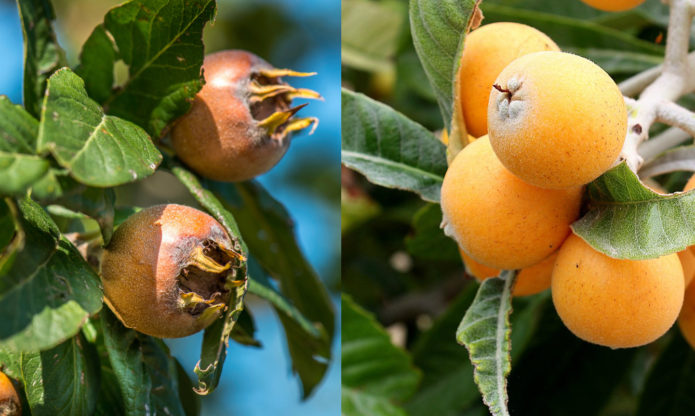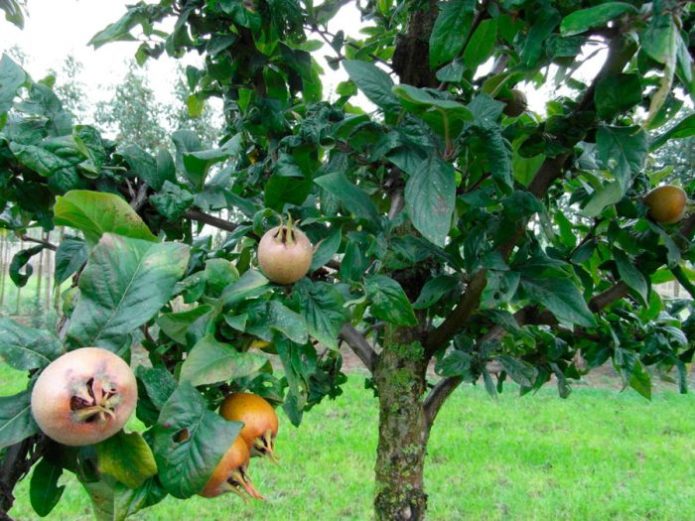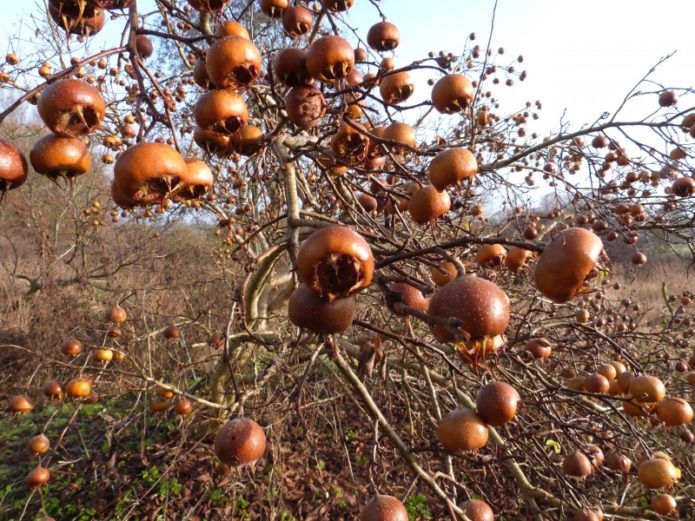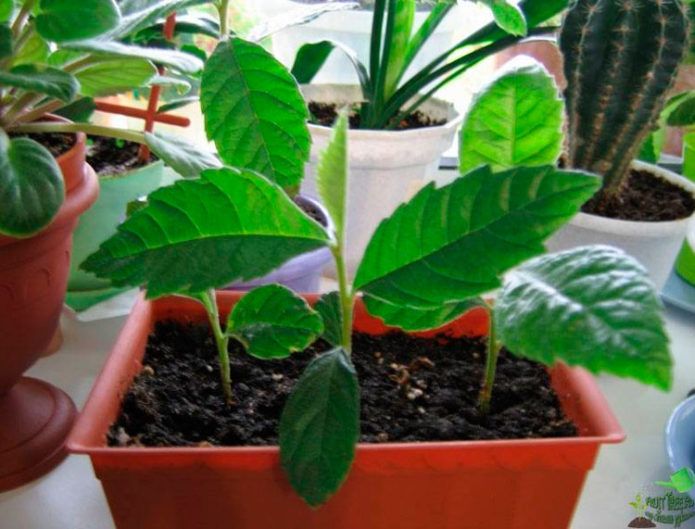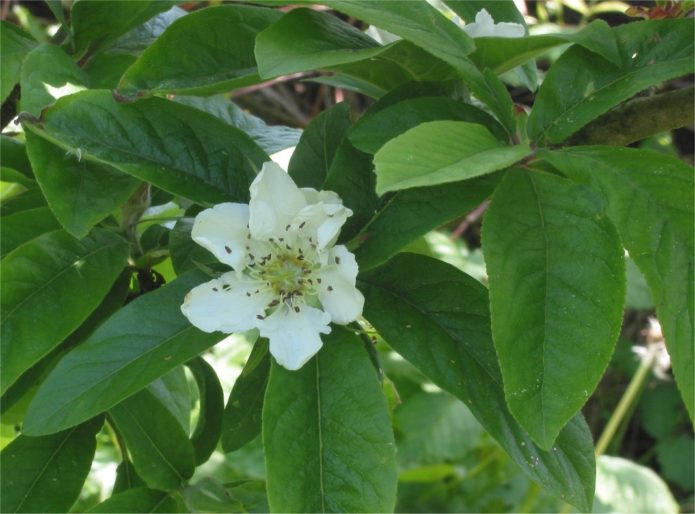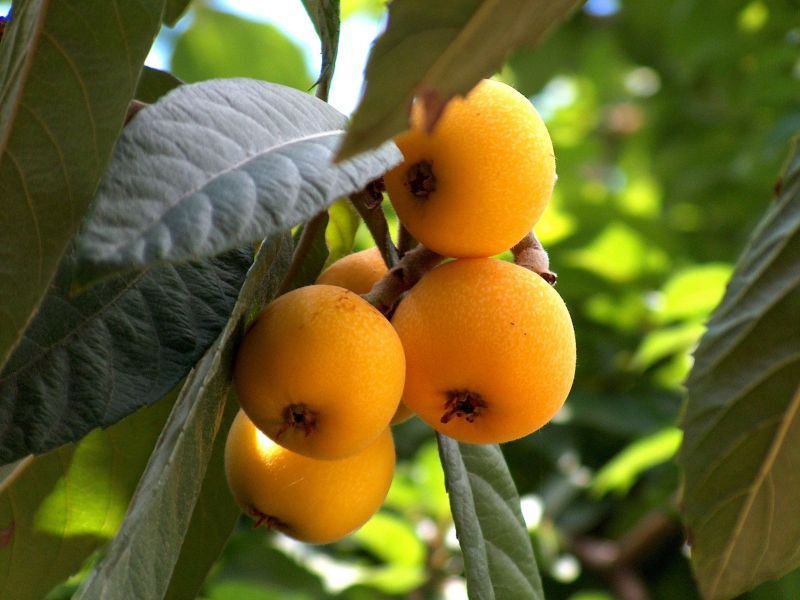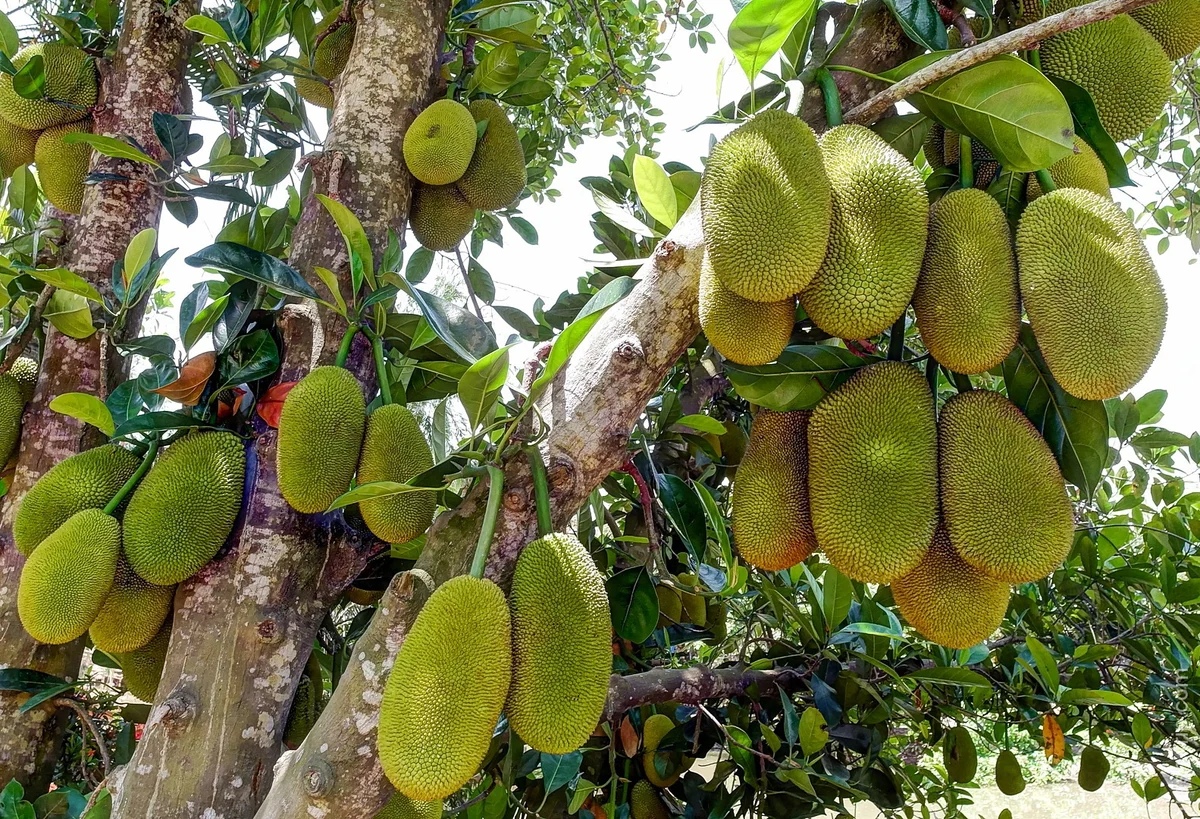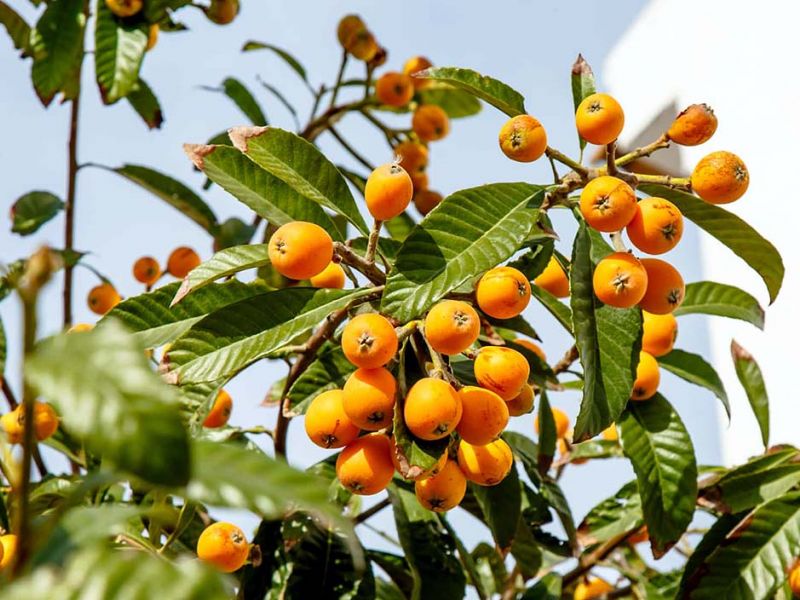Germanic medlar is a tree with a spreading crown, beautifully blooming in spring, and in autumn bearing unusual fruits. A native of the subtropics, in domestic areas it is considered exotic. However, experienced gardeners assure that the tree will take root even in temperate climates and will become a highlight of the backyard area.
Content
Germanic and Japanese medlar: what is the difference (photo and description)
The most common types of medlar are Germanic (also known as Caucasian medlar) and Japanese (lokva). Both trees grow under favorable conditions up to 4–8 m and are outwardly similar, but have significant differences:
- in the Japanese, the leaves are slightly pubescent, slightly wrinkled, and in the German - shiny, as if covered with wax;
- lokva blooms in October - November and bears fruit by May - June, while the Caucasian one blooms in May - June, and pleases with fruits by autumn;
- fruit Japanese medlar they look like apricots, they are sweet and pleasant to the taste, while in the German one they are sour, and they can be eaten only after frost or artificial freezing;
- lokva does not tolerate low temperatures and in most regions of Russia it will not survive due to the harsh climate (it is grown in open ground only in Crimea), but some varieties of Caucasian medlar are resistant to cold winters, and therefore it is this type that domestic gardeners choose for growing ...
Why is it worth growing the Caucasian medlar in your garden
As a garden crop, medlar is grown for the purpose of landscape design and use for medicinal purposes.
Beneficial features
The fruit of the plant contains:
- vitamin C;
- pectin;
- minerals (calcium, potassium, magnesium);
- organic acids.
Thanks to these elements, the use of fruits:
- enhances immunity;
- improves the condition of blood vessels, fights bad cholesterol, normalizes blood pressure and blood clotting, prevents the appearance of blood clots, reducing the risk of developing cardiovascular diseases;
- has an astringent and bactericidal effect;
- removes phlegm;
- normalizes blood circulation, the work of the neuromuscular system, liver, endocrine glands, digestion;
- stimulates intestinal peristalsis;
- has a beneficial effect on the condition of hair, bones, nails.
Indications for the use of fruits are:
- diabetes;
- asthma;
- cough;
- high pressure;
- diseases of the heart and blood vessels;
- colic;
- liver and kidney disease;
- diarrhea and constipation;
- inflammation of the gastrointestinal tract;
- urolithiasis disease.
What problems do gardeners have with growing medlar:https://flowers.bigbadmole.com/en/sadovye-rasteniya/mushmula.html
Contraindications to use:
- individual intolerance;
- gastritis, proceeding against a background of high acidity;
- a stomach or intestinal ulcer;
- inflammation of the pancreas.
When using medlar for medicinal purposes, you must first consult a doctor.
Role in landscape design
Abundant foliage and a spreading crown define the functionality of an exotic tree in the design of the site:
- Usually medlar is used to create the center point of landscaping in a medium-sized garden;
- sometimes 2-3 trees are planted on the north side of other crops to create a windscreen;
- if space permits, several trees are settled along the path in the garden in order to obtain a park alley due to the closing crowns.
In temperate latitudes, the height of the medlar usually does not exceed 3-4 m. The decorativeness of the tree lasts a whole year:
- in winter the plant looks spectacular due to the intricately intertwined branches;
- from May to June, it is decorated with small light pink or white flat flowers;
- in summer, the tree attracts the eye with shining foliage swaying in the wind;
- in the fall, unusual fruits appear, and the leaves acquire a reddish-brown hue.
Growing conditions
In gardens, the tree is grown outdoors. For temperate latitudes, it is recommended to choose varieties that are resistant to cold weather:
- Karadag;
- Sochinskaya;
- Sweet Dracheva;
- Goytkhskaya;
- Khvamli.
Conditions most favorable for the cultivation of German medlar:
- Climate. The tree is thermophilic, but resistant to frost. Some species survive even at temperatures as low as –30 ° C.
- The soil. The fertility of the soil is not of great importance, however, excessive moisture and close-lying (less than 1 m) groundwater are contraindicated for the plant. Good drainage is required. The soil is neutral or slightly acidic.
- Illumination. For medlar, you need to select a well-lit area: in partial shade, the yield of the tree is significantly reduced.
Landing
Gardeners recommend purchasing seedlings from a specialized nursery to ensure that they are adapted to local climatic conditions. However, there are other options as well.
Growing seedlings
You can grow a seedling from a bone, by cutting or grafting.
From seeds
Only fresh seeds are suitable, as their germination decreases over time:
- Soak 5% in sulfuric acid for 5 hours, then rinse thoroughly. This will help speed up the germination process: in nature, sprouts appear only 2-3 years after the seeds enter the soil.
- Leave for 6-8 hours in Kornevin's solution.
- Plant 3–4 cm deep in pots filled with flower growing medium. 5-6 seeds per container, with a volume of 1-1.5 liters.
- Cover with foil and keep warm.
- Every day for 2–3 hours do "airing", removing the film. Water as the earthen coma dries. After 1.5 months, the seeds should germinate.
- When the sprouts reach a size of 2-3 cm, the film can be removed.
- After the formation of 2-3 leaves, plant in separate containers.
- When the seedlings grow up to 20–35 cm, you can move them to the site.
Bones are also planted in open ground at the end of October or in the first days of November, by mulching the soil with sawdust or peat, or covering it with polyethylene. However, this method is only suitable for areas with warm winters.
By cuttings
Growing a German medlar seedling by cuttings is carried out as follows:
- Divide the cuttings into pieces, 15–20 cm long, so that in this area there are 2-3 internodes. Cut the lower end at an angle of 45 ° and sprinkle both edges with ash. Cut the leaves in half.
- In an opaque container (the roots need protection from light) with a thick drainage layer, root the cuttings 4–5 cm vertically.
- Drizzle abundantly, cover with a plastic bag.
- Put away in a warm place, preferably near the battery.
- Remove the bag for a couple of hours a day and water the soil as needed, but infrequently.
- After rooting (after about 2 weeks), plant the cuttings separately, and when spring comes, plant them in open ground.
Layers
If there is already an adult tree in the garden, they do this: the branches are bent to the ground and fixed, cutting the bark at the attachment point. A seedling is formed within 2 years.It will be possible to plant it in the fall, after the leaves fall.
Planting a seedling
It is recommended to plant seedlings in the spring, after frosts with the onset of stable heat. This is done like this:
- Dig a hole, the volume of which is one third larger than the roots of the tree.
- Place a layer of drainage, compound fertilizer and bone meal on the bottom.
- Place the seedling in a hole and sprinkle with such a substrate: dug soil, peat, sand and humus mixed in equal proportions.
- Dig in the support immediately. It is required during the first 2-3 years of a tree's life to maintain a heavy crown.
- Water well, mulch the trunk circle with humus or compost.
When choosing a site for planting, it is important to take into account that the comfort zone of a tree is an area of 1.5x1.5 m.In this area, it is not recommended to plant other crops that will take away the nutrients needed by the medlar.
With proper care, trees begin to bloom and bear fruit in the 4th year of life.
In the shade of the crown of the medlar, you can plant low perennials or shade-loving perennials:https://flowers.bigbadmole.com/en/sadovye-rasteniya/tenelyubivye-mnogoletnie-i-odnoletnie-cvety-v-sadu-cvetuschie-vse-leto.html
Care features
Caring for a tree does not require much effort and is almost identical to caring for fruit crops familiar to a domestic gardener.
Watering
Moderate watering is favorable for the plant, in no case should excessive soil moisture or liquid stagnation be allowed.
In the phase of flowering and fruit formation, it is necessary to provide the tree with regular watering: the drying of the substrate will affect the yield.
Top dressing
Replenishment with standard minerals and organics is carried out at intervals:
- 2-3 times a season for mature trees;
- once every 3 weeks for seedlings.
Pruning
In the care of the medlar, pruning is carried out:
- decorative - for crown formation;
- sanitary - getting rid of damaged, dried up and diseased branches, which is important for the health and fruitfulness of the tree;
- spring - removal of frozen shoots and thinning of branches.
Gardeners recommend cutting the branches of seedlings by about half in the first 2-3 years of the tree's life.
How to properly carry out spring pruning of fruit trees:https://flowers.bigbadmole.com/en/derevya/kak-pravilno-vesnoy-provesti-obrezku-plodovyh-derevev.html
Preparing for winter
German medlar, especially some of its varieties, tolerates frost well. In the southern regions, it will survive the cold season even without shelter. In areas with a more severe climate, it is recommended:
- mulching the soil (this is especially important in the first 1-2 years of plant life);
- cover the trunk with spruce branches to protect it from the cold and rodents.
Potential problems and solutions
German medlar is considered an unpretentious plant, and although problems with its cultivation rarely arise, consider the most common of them.
Insect pests
Most often, the tree is attacked by aphids, worms, scale insects, so gardeners recommend treating the plant with insecticides for prevention 2 times a season:
- "Lepidocide" (20-30 g per 10 liters of water);
- Fitoverm (1.5-2 ml per liter of water);
- "Insegar" (5 g per 10 liters of water), etc.
If there is already a problem, insecticides are applied according to the instructions.
There is a high likelihood of damage by caterpillars eating leaves. Therefore, 3 times in the spring and summer it is necessary to treat the plant with "Chlorophos" (0.2%) and "Karbofos" (0.3%) - these funds are used both for prevention and for solving the problem.
Root rot
The main reason for the phenomenon is waterlogging of the soil (prolonged rains, excessive watering). To eliminate the problem, you can add fungicides to the soil.
The German medlar is a beautiful tree that pleases the eye with its unusual crown, beautiful flowering and healthy fruits. And the frost resistance and unpretentiousness of the plant make it a welcome tenant even in regions with harsh winters.
